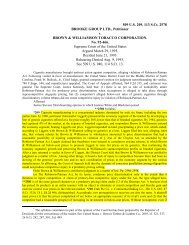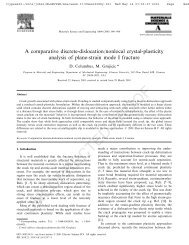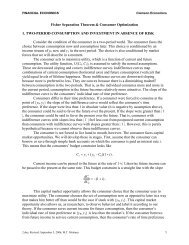a tribute to professor walter shepherd owen - Clemson University
a tribute to professor walter shepherd owen - Clemson University
a tribute to professor walter shepherd owen - Clemson University
You also want an ePaper? Increase the reach of your titles
YUMPU automatically turns print PDFs into web optimized ePapers that Google loves.
volume enclosed by a surface at which the von Mises criterion for yielding is satisfied. The<br />
effect of yielding-induced stress relaxation on the size of the transformation zone was not<br />
considered since in order <strong>to</strong> understand thermo-elastic growth, it is important <strong>to</strong> know only<br />
whether or not significant plastic flow occurs.<br />
The elastic properties of the matrix were found <strong>to</strong> play a significant role in the process of<br />
accommodation. In this regard, a favorable fac<strong>to</strong>r for thermo-elastic growth is pre-martensitic<br />
elastic softening of the lattice (Figure 5), which may be caused by different phenomena in<br />
different alloy systems. Alloys that transform thermo-elastically all have an anomalous positive<br />
temperature dependence of the elastic constant C’ = (C11 - C12)/2 over a temperature range that<br />
includes the Ms temperature. Elastic softening affects the transformation in two ways: it reduces<br />
the chemical driving force at the nucleation stage, and it facilitates the elastic accommodation of<br />
the lattice shape change. Thus, a plate that grows thermo-elastically at Ms will continue this form<br />
of growth as the temperature is lowered.<br />
Figure 5. Temperature dependence of<br />
the average shear modulus, G, as a<br />
function of the degree of order S in<br />
Fe3Pt [20].<br />
Most thermo-elastic alloys possess long-range order which increases their yield strength and,<br />
thus, inhibits plastic yielding. Alloys that are ferromagnetic at the Ms temperature, such as Fe3Pt,<br />
are further strengthened by a magne<strong>to</strong>striction effect known as "Invar strengthening," which is a<br />
function of the degree of order, S [23]. Ling and Owen [19,20] made a major contribution <strong>to</strong> our<br />
better understanding of the role of long-range order in accommodation of the macroscopic shape<br />
change accompanying martensitic transformation. An example of the results obtained by Ling<br />
and Owen [19,20] pertaining <strong>to</strong> the size of the yield envelopes associated with an isolated<br />
martensite plate as a function of the degree of long-range order S is shown in Figure 6. The<br />
change in the yield-envelope size demonstrates the importance of long-range order. A thin plate<br />
(aspect ratio = 0.02) in a disordered matrix (S =0) is completely enclosed within a yield<br />
envelope. However, in all cases where S > 0.2, matrix yielding is confined <strong>to</strong> a small zone at the<br />
radial edge of the plate. The change is particularly striking between S =0 and S =0.2. Over this<br />
8<br />
Figure 6. Matrix yield stress con<strong>to</strong>urs<br />
of an oblate spheroid lying in the x-y<br />
plane with the transformation shear in<br />
the x direction [20].

















